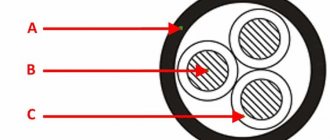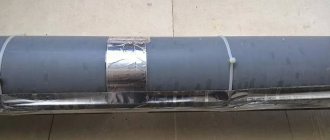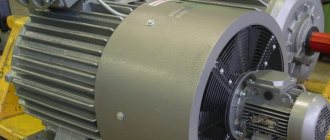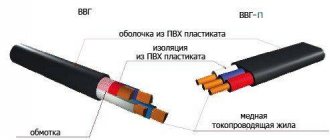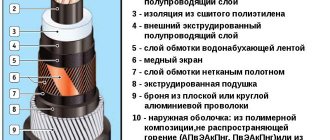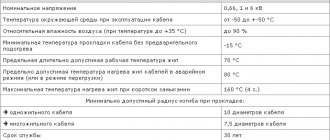Most industrial and household electrical equipment is designed to work with electrical networks up to 1000V. To distribute electricity in networks of this level, reliable power cables are needed. VVG fully meets such tasks; it is widely used in wiring and lighting lines.
Many types of VVG are produced, differing in their main characteristics, which allows you to choose the most optimal option for a particular task.
Variety of VVG types
To accurately determine the type of cable product, it is marked in accordance with the national standard GOST 53769–2010.
How the marking is deciphered
Since 2010, a unified system has been used in the Russian Federation for marking cable products (660V, 1000V and 3000V), its principle is shown in the figure.
What do the fields on a marking record mean?
Below is a table that explains the VVG markings (first and second fields).
| A | B | B | G |
| If it is present in the designation, it means the wires are made of aluminum; when there is no letter, the wires are made of copper. | Type of wire insulation, “B” - means polyvinyl chloride (PVC) is used | Outer shell material, “B” - PVC | There is no protective layer (armor) |
After an abbreviation of three or four letters (VVG or AVVG), the marking indicates how many wires and their cross-section (in mm2). Next come the letters characterizing the type of core:
- “O” - indicates that monolithic conductors (single-wire) are used;
- “M” – wires consist of several cores (multi-core wires);
- After which the shape of the wires is indicated: “C” - sector or “K” - round.
Round (1) and sector (2) conductors
If, in addition to the main wires, there are conductors with a smaller cross-section (PE and (or) N wire), a + sign is placed, after which the number of such wires and their cross-section are indicated. After this, the purpose of such conductors is given in parentheses (PE - grounding, N - zero).
The marking is completed by indicating the rated voltage (kV), optimal climatic conditions (optional) and specifications or GOST.
Let us decipher the VVG marking 3x25ms+1x16ms(N)-1 as an example. From the designation it becomes clear that this electrical cable does not have armor (letter “G”), the sheath and insulation of the wires is made of polyvinyl chloride (designation “BB”).
It has four sector stranded conductors, three of them with a cross-section of 25 mm2 (3x25ms) and one used as a zero - 16 mm2 (1x16ms(N)). This type of cable product can be used in electrical networks up to 1000 V (last parameter “1”).
Marking of power cables
Chapter 4 GOST regulates the classification of cables. It contains a description of the abbreviations used and defines the order of their use in the symbols.
Let's see what the abbreviation VVG shows, deciphered in accordance with the standard:
- In the first place is the material used in the conductive conductors. The letter "A" indicates the use of aluminum. When using copper, the designation is put on. Accordingly, we have a copper wire;
- In second place, the insulation material is indicated. The letter “B” denotes polyvinyl chloride plastic;
- Another letter “B” indicates the wire sheath material. In our case, it is the same with insulation;
- The last letter - “G”, indicates the absence of armoring of the conductive core.
Thus, it is possible to decipher any symbol used in the marking. The VVG wire, considered as an example, has copper, unarmored conductors, sheathed in polyvinyl chloride plastic and insulated from the same material.
By analogy, it can be determined that for the VVG brand with the index “P” the decoding will correspond to that already given, with the exception of the geometric shape. The letter “P” gives an additional characteristic regarding the cross section. The wire marked with this index is flat, and the wires in it are arranged in one row.
Device
Let's look at how a regular two-core VVG and its modification VVGng (flame retardant) are constructed.
Main components of VVG
As can be seen from the figure, the design of a two-core VVG is quite simple; it includes two copper wires “C”, each of which is covered with a layer of polyvinyl chloride insulation “B”. The conductors are placed in a protective PVC sheath “A”.
Now let's see how the three-core VVGng, shown in the figure below, is constructed.
Installation of VVGng electrical cable (flame retardant)
Designations:
- A – copper conductors;
- B – heat-resistant barrier;
- C – polyvinyl chloride insulating coating;
- D – heat-resistant filler;
- E – protective shell made of polyvinyl chloride.
As you can see, the main difference between the two types of electrical cables is the presence of thermal protection in the latter (not taking into account the number of wires).
Peculiarities
NYM is used for indicators from -30С to +40С. Productivity is ten years longer and, according to the manufacturer, is forty years. Not subject to combustion only in a single gasket. It is recommended for installation at hazardous facilities, where complete sealing of inputs into equipment is necessary. It is better to choose it for a device in hazardous conditions.
Any of the compared samples has certain advantages and should be used based on the characteristics of the structure for the communication of electricity.
- a certain filler ensures high plasticity and reliability of the product;
- additional rubber insulation provides maximum moisture protection;
- ease of installation due to simple cutting;
- easy sealing of the input due to the cross-section of a regular circle;
- presentable appearance;
- durability.
NYM or VVGng: what is the difference and what is better to choose for wiring
The PPG cable includes one or more conductive cores of the first and second class. It contains a PVC insulating layer covering each core, with an inner PVC sheath that provides cable protection. It contains the outer shell of insulation.
Expert opinion
It-Technology, Electrical power and electronics specialist
Ask questions to the “Specialist for modernization of energy generation systems”
NYM or VVGng - which cable is better for installation When choosing a cable that is better suited for the upcoming work, you should take into account such details as the features in which the product will be used. Ask, I'm in touch!
Scope of application
The scope of application of VVG electrical cables is regulated by the national standard - GOST R53769–2010, the main criterion of which is to ensure the required degree of PB. According to the specified requirements, these cable products can be used when organizing single-type lines for power supply and lighting. VVG can be laid in a damp room.
It is allowed to use this type of cable product for group installation, but only in cases where the line is equipped with all the necessary fire protection equipment.
Decoding the abbreviation
The VVGN cable must comply with GOST 31996-2012. In the name, each letter stands for:
- B – the first letter in the name means vinyl (more precisely polyvinyl chloride);
- B – the second letter means that the cable has a second layer of insulation, which is also made of vinyl;
- G - the third letter indicates that the cable has no armor. This provides flexibility although it is less stable. This characteristic makes conductors of this type widely popular.
- NG - the presence of these letters in the name indicates that the cable is resistant to fire when laid together. When laid alone, almost all wires do not ignite. And to ensure this property during group installation, the cable is coated with a special solution.
Modern VVGng GOST cable may also have modifications:
- LS – gas and smoke are released in reduced quantities;
- HF – no gaseous products are released during combustion.
Main characteristics
One of the main characteristics indicates the nominal and minimum thickness of the insulating coating; it depends on the voltage and cross-section of the wires.
| Threshold voltage value (V) | Ø wires (mm2) | Nominal layer of insulation coating (mm) | Minimum permissible layer of insulating coating (mm) |
| 660 | From 1.00 to 2.50 | 0,62 | 0,46 |
| From 4.00 to 6.00 | 0,71 | 0,54 | |
| From 10.00 to 16.00 | 0,93 | 0,72 | |
| From 25.00 to 35.00 | 1,12 | 0,90 | |
| 50,00 | 1,32 | 1,08 | |
| 1000,0-2500,0 | 0,80 | 0,64 | 0,54 |
| From 4.00 to 16.00 | 1,10 | 0,82 | |
| From 25.00 to 35.00 | 1,22 | 1,02 | |
| 50,00 | 1,44 | 1,18 |
The next most important parameter is the characteristics of the insulating layer of the sheath; they depend on the total cross-section of all the wires of the electrical cable.
| Overall Ø (mm2) | Nominal layer of insulating sheath (mm) | Minimum insulation layer (mm) |
| Until 6.00 | 1,22 | 0,94 |
| From 6.00 to 15.00 | 1,54 | 1,20 |
| From 15.00 to 20.00 | 1,72 | 1,36 |
| From 20.00 to 30.00 | 1,92 | 1,54 |
| From 30.00 to 40.00 | 2,14 | 1,70 |
The threshold electric current strength, this indicator may depend on how many wires are in the cable and what their cross-section is. In addition, the location of the electrical cable (overhead line or underground wiring) influences. We recommend that you check this specification when purchasing cable products. Below is a table showing the threshold electric current for overhead lines.
| Ø(mm2) | Permissible electric current threshold (A) | ||
| two-wire | three-wire | four-wire | |
| 1,50 | 24,00 | 21,00 | 19,00 |
| 2,50 | 33,00 | 28,00 | 26,00 |
| 4,00 | 44,00 | 37,00 | 34,00 |
| 6,00 | 56,00 | 49,00 | 45,00 |
| 10,00 | 76,00 | 66,00 | 61,00 |
| 16,00 | 101,00 | 87,00 | 81,00 |
| 25,00 | 134,00 | 115,00 | 107,00 |
| 35,00 | 166,00 | 141,00 | 131,00 |
| 50,00 | 208,00 | 177,00 | 165,00 |
The resistance of the wire depends on its cross-section; this parameter is given in the table below (the values are indicated for direct electric current)
| Ø (mm2) | 1.50 | 2.50 | 4.00 | 6.00 | 10.00 | 16.00 | 25.00 | 35.00 | 50.00 |
| Resistance value of one wire (Ohm/km) | 12.0 | 7.40 | 4.60 | 3.10 | 1.80 | 1.20 | 0.73 | 0.52 | 0.39 |
Types of VVG cable
The following types of VVG power cables have been invented for various tasks:
- VVGng, meaning - non-flammable;
- VVGng ls, labeling - without the formation of smoke and gas during fire;
- VVGng FRLS - resistant to high temperatures;
- VVG p - flat in shape;
- VVGng (a) - fire resistant.
Each of these types has special technical characteristics .
- VVGng 's characteristics are distinguished by their versatility. Copper power cable is compatible with installation in water, on land, at altitudes up to 4300 m, in dry and wet areas. Does not spread fire. Explanation VVGng - “vinyl/vinyl/naked/non-flammable.” The number of cores is from 1 to 6, if there are more than two, twisting is performed.
- For the VVGng Is the technical characteristics are slightly different. The fact is that it was created for places with a particularly high risk of fire. For VVGng Is, the decoding of the marking looks like this: vinyl/vinyl/naked/non-flammable/low smoke level (ls, or “Low Smoke” translated from English means “little smoke”). It also has a subtype VVGng A Is with the following decoding: (A) - fire non-propagation category according to GOST. The differences are that they can be laid in bundles; the form factor can be round, triangular, or flat. This type of circular wiring uses devulcanized rubber and halogen-free core + sheath with flame retardant properties. The maximum temperature of current-carrying conductors during a short circuit is +400⁰С.
- VVGng FRLS - the same as NG, only in English. FRLS stands for Fire Resistance Low Smoke.
Pay attention to the flammability tests of various VVG wires.
Another interesting test of different cables:
How to store
The power cable must be stored indoors, where there is no access to weather conditions, or under a canopy. Storage in an open-air area is allowed, provided that the cable is in a lined drum.
Covered Drums
Acceptable storage period:
- indoors (where there is no access to atmospheric influences) no more than 10 years;
- area covered with a canopy – 5 years;
- open area – 2 years.
How to choose a wire cross-section?
There is a table of correspondence between wire cross-section and load (shown below). It indicates what maximum load corresponds to what cross-section of copper conductor.
| Core cross-section, mm2 | 1.5 | 2.5 | 4.0 | 6.0 | 10.0 | 16.0 | 25.0 | 35.0 | 50.0 |
| Current load, A | 19 | 27 | 38 | 50 | 70 | 90 | 115 | 140 | 175 |
So, suppose you need to select a wire for wiring in the kitchen. For example, the kitchen has a 1.6 kW boiler, a 0.4 kW refrigerator, a 1.8 kW microwave and a 1.2 kW toaster. In this case, the total current load will be as follows:
(1600+400+1800+1200)/220=22.7 A
It is also necessary to multiply the current load by a power reserve factor of 1.5, since the number of electrical appliances may increase in the future. In total we get:
22.7x1.5=34.05 A
Now we look at the plate and see that our load corresponds to a wire with a cross section of 4 mm2 .
Using the same principle, the wire cross-section is selected for all other rooms and for the input cable.
Weight and dimensions of the packaged electrical cable
The dimensions of the drum or coil, as well as their weight, depend on the purpose of packaging (storage or transportation). These parameters can be found on the websites of cable manufacturers or their regional dealers. As practice shows, the declared dimensions and weight may have a deviation of around 10%.
Operating conditions:
- First of all, you need to adhere to the temperature regime. According to the technical characteristics, VVG can be operated in the temperature range from -50°C to 50°C. Short-term heating of the cable to a temperature of no more than 90°C is allowed.
- When laying an electrical cable, it is impossible for its temperature to drop below -15°C; this can lead to the “fragility” of the PVC material from which the protective sheath and insulation are made. In this case, heating will be necessary.
- Humidity threshold no more than 98%.
- When laying, bending less than ten diameters of the electrical cable is not allowed.
- Compliance with operating conditions guarantees the service life of VVG cable products up to 30 years.
Use and laying rules
The main area in which VVG cable is used is electrical networks with voltages up to 1 kV. Recommended for single installation of lighting and power lines. Subject to meeting additional requirements in the field of fire protection, its use for group installation is permitted.
The lack of protection imposes certain restrictions on the conditions under which the VVG cable must be laid. According to general recommendations, it can be performed on surfaces made of non-combustible or low-combustible materials. It is possible to lay cables on suspended structures. In this case, it is necessary to ensure the required structural rigidity to exclude mechanical damage. Taking into account the weight of the VVG cable, when laying externally, free sagging, causing uncontrolled stretching of the cores, must be excluded.
Open installation on wooden structures is not recommended due to possible mechanical damage. This problem is eliminated by the use of additional external protection in the form of a pipe, metallized or corrugated hose with sufficient strength characteristics.
Hidden gasket is widely used in construction. If the requirements for the non-combustibility of the underlying surface are met, it is allowed to be laid under plaster, in special niches or prepared cable routes.
Concealed installation outside of building structures, carried out directly in the ground, is not recommended. In this case, the VVG cable may be exposed to dangerous external influences, both man-made and natural. Lack of protection in the form of armor can lead to destruction of the insulating layer or damage to current-carrying conductors.
As with gaskets in wooden structures, additional methods of protection come to the rescue. The use of pipes, concrete or composite cable trays will allow installation in the ground. At the same time, the integrity of the building structure protecting the cable must be ensured.
Description and technical documentation
The main document defining the technical parameters and conditions for the production of cable and conductor products of this class is the Russian standard of 2010 GOST 53769 - 2010 “Power cables with plastic insulation...”. This standard contains all the general requirements for products of this type, namely, for conductor cable products used for voltage 0.66; 1.0 and 3 kV.
This state standard also normalizes a unified marking system for this type of cable products. It should be especially noted that the technical specifications of the plants producing cable and wire products are developed on the basis of this GOST. In addition, any products manufactured by enterprises are subject to mandatory certification, this is another one of the requirements of this GOST.
One of the main parameters of power supply cables in accordance with GOST 53769 - 2010 is the degree of its fire safety , namely, laying conditions, temperature conditions of operation, necessary fire protection measures.
